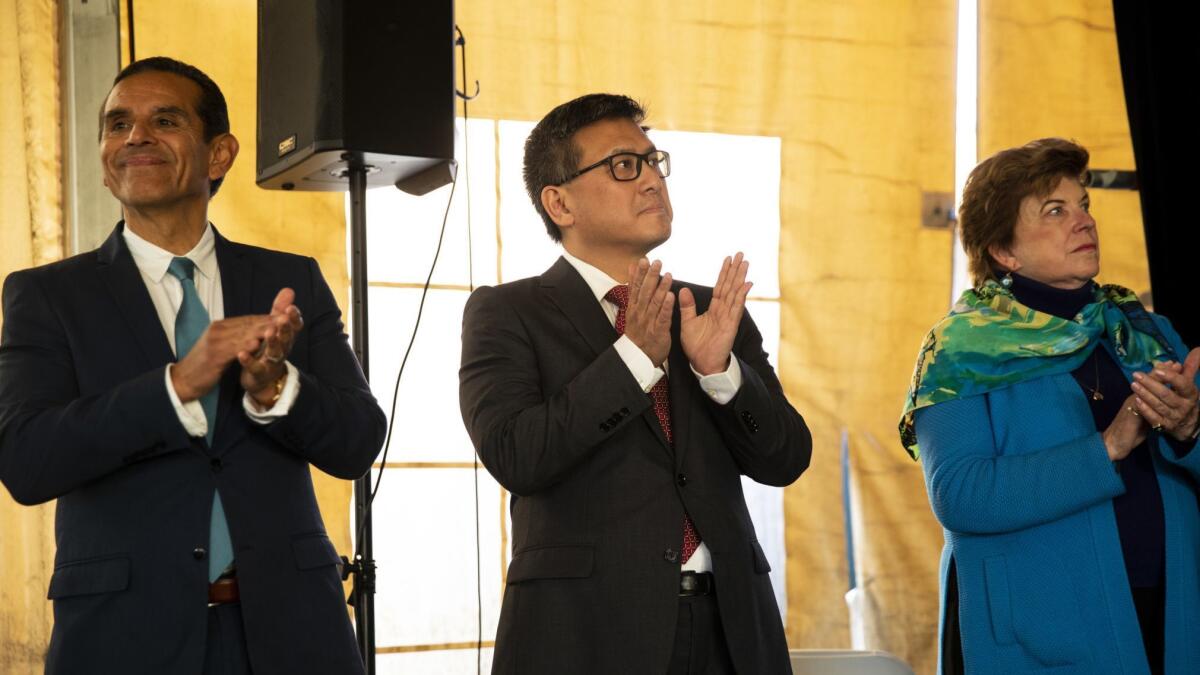Capitol Journal: California’s top-two primary could be rendered useless thanks to a hyper-polarized electorate

Reporting from Sacramento — On paper, California’s “top two” open primary made sense: When one political party dominated an election, the weaker party could support a consolation moderate.
This seemed especially beneficial for Republican voters in statewide races. The GOP was plummeting into irrelevance. Rather than a lefty Democrat being elected almost automatically over a noncompetitive Republican nominee, there’d be a second, less objectionable Democrat on the ballot.
Republicans could swing the election toward the lesser of two evils.
But the whole theory collapses if voters are so polarized that they refuse to vote for any candidate from the other party.
That’s what we’re potentially looking at this year in the gubernatorial election to replace fiscal centrist Gov. Jerry Brown.
The Republican and Democratic voter bases are hyper-polarized. They’re mistrustful and intolerant of each other. Democrats easily have the upper hand in California, out-registering declining Republicans by 44.6% to 25.3%. Independents are nearly as numerous as Republicans, totaling 25.1% of registered voters, and they lean Democratic.
The dynamics are these: The most liberal of the major Democratic candidates is Lt. Gov. Gavin Newsom, the former San Francisco mayor. He has led everyone from the start, based on polls. He’s expected to win the top spot in the June 5 primary and advance to the November runoff.
The crucial primary race is for the second runoff spot. Under top-two rules, a candidate’s party doesn’t matter.
If the second-place finisher is a Republican — Rancho Santa Fe businessman John Cox or Huntington Beach Assemblyman Travis Allen — Newsom’s election in November is virtually clinched. Neither weak Republican could attract enough independents, let alone Democrats, to win.
Newsom was extraordinarily candid about that during a televised debate last week. Candidates were asked whether they’d rather face a Democrat or a Republican during the general election.
“A Republican would be ideal,” Newsom quickly replied, smiling. Turning to Cox and Allen, he added: “Either one of these will do.”
No Republican has won a statewide race in California since 2006.
There are two relatively moderate Democrats on the ballot: Former Los Angeles mayor and Assembly speaker Antonio Villaraigosa and state Treasurer John Chiang. Another Democrat, former state schools chief Delaine Eastin, is as liberal as Newsom without the campaign money.
Much of the business community is rooting quietly for Villaraigosa. But it hasn’t helped him.
“Until there’s evidence a candidate has a chance, people aren’t looking to go stick a finger in Newsom’s eye,” one business strategist told me.
Coverage of California politics »
Villaraigosa should have some appeal to Republicans: As mayor, he took on the powerful teachers union in a partially successful effort to improve schools. He chopped paychecks and pensions of city employees to balance the budget. And he has repeatedly branded as “snake oil” outrageously expensive single-payer healthcare legislation pitched by Newsom.
Republicans could vote in the primary for Villaraigosa or Chiang and guarantee real competition against Newsom in November. But they’re apparently not in the mood to help any Democrat, especially when California Democrats and President Trump are at war.
“It’s the reflection of the times,” says Mark DiCamillo, polling director for the UC Berkeley Institute of Governmental Studies. “It’s hyper-partisanship…. Republicans have come to the judgment that they’re going to vote for one of the Republicans.”
In a late April survey, the pollster found these results: Newsom 30%, Cox 18%, Allen 16%, Villaraigosa 9%, Chiang 7%, Eastin 4%, undecided or “other” 16%. Since then TV ads have been running, so the standings may have changed.
DiCamillo’s most significant finding was this: Villaraigosa and Chiang each drew only 1% of the Republican vote, Newsom 2%. Cox and Allen attracted 2% and 3%, respectively, of the Democrats’ support. So voters aren’t buying into the open-primary concept of alternative choices.
Inserting a bipartisan election process into partisan politics has generated loud squeaks and stout resistance.
“Voters don’t have an inclination to vote for someone from the other party,” veteran Democratic consultant Bill Carrick says. “In the past, they voted with the other side a little more. There were Reagan Democrats and Clinton Republicans.”
The main goal of open-primary advocates was to moderate the Legislature. After several summers of embarrassing itself with childish budget gridlocks, the Legislature was forced to place an open-primary measure on the ballot in exchange for a late-night tax vote by then-Sen. Abel Maldonado (R-Santa Maria). Voters approved the measure in 2010.
The perpetual budget battle snafu was resolved when the electorate lowered the required legislative vote for a budget from two-thirds to a simple majority. But has the Legislature become more moderate?
Democrats are “somewhat more moderate,” says Eric McGhee, politics researcher for the Public Policy Institute of California. But he adds: “There is no evidence of increased moderation among Republicans.”
The Democrats’ moderation probably also results from two other reforms, he says: honest redistricting of legislative seats and more flexible term limits.
Marty Wilson, political strategist for the California Chamber of Commerce, says there’s talk of scuttling open primaries for statewide races but retaining them for legislative and congressional contests.
“It’s a little premature to say the system is not working,” he says. “Let’s see how it comes out this year.”
Fine. But if there were party nominations again for governor, it might lure more qualified Republicans into the race. There’d be a guaranteed ballot slot for a Republican in November.
Depending on what happens this November, maybe we should consider reforming the reform.
Follow @LATimesSkelton on Twitter
More to Read
Get the L.A. Times Politics newsletter
Deeply reported insights into legislation, politics and policy from Sacramento, Washington and beyond. In your inbox three times per week.
You may occasionally receive promotional content from the Los Angeles Times.











